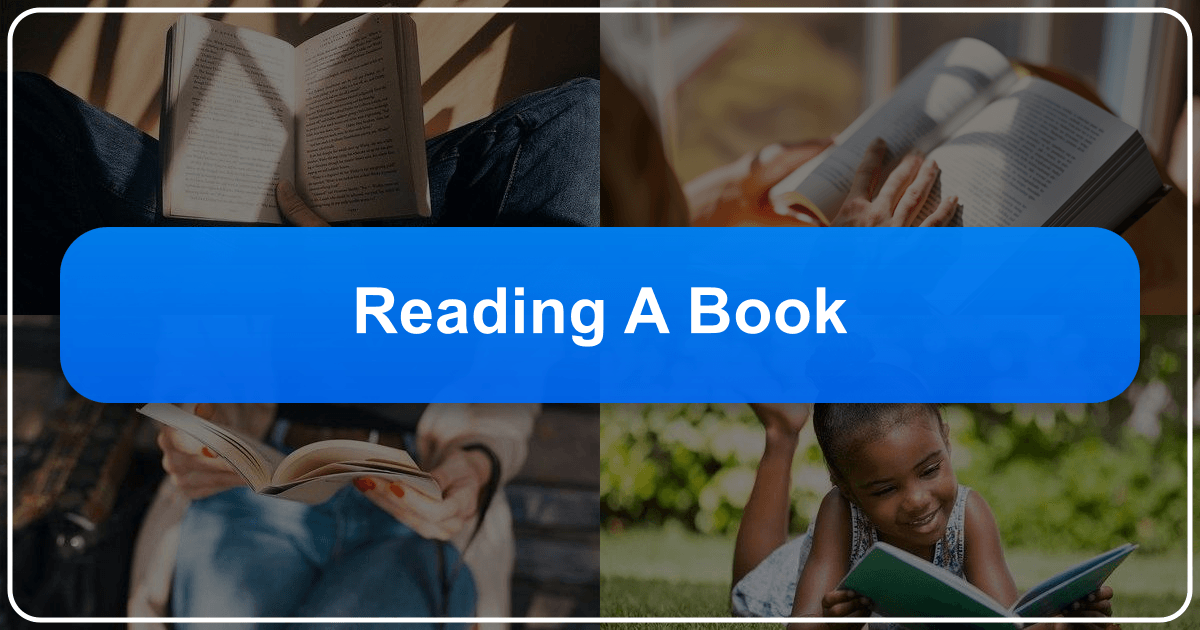Reading a Book: A Comprehensive Exploration

Reading, a fundamental human activity, transcends mere entertainment. It’s a gateway to knowledge, empathy, and personal growth, profoundly impacting individuals and shaping cultures. This exploration delves into the multifaceted world of reading, examining its various aspects, from the mechanics of fluency to its broader cultural significance.
The Art and Science of Reading Fluency
Reading fluency, the ability to read accurately, quickly, and expressively, is paramount, particularly for young readers. It’s not merely about decoding words; it’s about comprehending meaning and engaging with the text. A fluent reader effortlessly processes words, allowing them to focus on the narrative’s intricacies, fostering deeper understanding and enjoyment. Conversely, struggling readers expend significant mental energy on decoding, hindering comprehension and potentially dampening their enthusiasm for reading.
Fluency develops gradually through consistent practice. Initially, reading may be slow and laborious as readers grapple with phonics and word recognition. However, with time and experience, this process becomes automatic, enabling effortless reading aloud with natural expression, mirroring conversational speech. Fluent silent reading allows for immediate word recognition and simultaneous comprehension, facilitating the formation of connections between textual ideas and prior knowledge.

Assessing a child’s reading fluency involves attentive listening, focusing on several key indicators:
-
Phrasing and Smoothness: Does the child read word-by-word, hesitating frequently? Do they read in short, disjointed phrases, neglecting punctuation? Or do they read with appropriate phrasing and rhythmic flow?
-
Pace: Is the reading slow, erratic, or conversational? A conversational pace indicates a comfortable reading speed.
-
Expression and Volume: Is the reading monotone and quiet, or does it demonstrate varied volume and expressive intonation? Expressive reading reflects engagement and understanding.
The ideal reading experience should be natural and engaging, guided by punctuation and characterized by a conversational pace and expressive delivery. The volume should match the level of a casual conversation, creating a natural and enjoyable reading experience.
Practical Strategies for Building Fluency
Parents and educators can employ various strategies to cultivate reading fluency:
-
Paired or Buddy Reading: Reading aloud together, taking turns reading passages, models fluent reading. The child’s reading will naturally improve by mimicking the fluent reading style. This approach works especially well for several pages of the same book.
-
Rereading Favorite Books: Repeatedly reading familiar books builds confidence and automaticity in word recognition. With each rereading, the child’s speed, accuracy, and expression typically improve.
-
Reader’s Theater: Using scripts or poems allows for repetitive reading practice in a fun, engaging format. The collaborative nature of Reader’s Theater encourages expressive reading and reduces pressure.
-
Audio Recording: Creating audiobooks allows children to hear their own reading, providing immediate feedback and motivating them to improve their fluency. Sharing the recordings with family and friends provides additional encouragement.
-
Listening to Audiobooks: Listening to fluent readers provides an excellent model for children to emulate, exposing them to expressive reading and expanding their vocabulary.
Selecting Appropriate Reading Materials
Choosing the right books is crucial for building fluency. Two key categories exist: books for parents/educators to read aloud and books for the child to read independently.
-
Books for Reading Aloud: Select engaging books with lively characters and extensive dialogue. Use different voices to enhance the narrative, modeling expressive reading. Choosing books slightly above the child’s independent reading level introduces them to more challenging texts while making the experience enjoyable.
-
Books for Independent Reading: Apply the “Goldilocks Principle”—select books that are “just right,” neither too easy nor too difficult. These books should seem almost effortless for the child to read, enabling them to focus on fluency rather than decoding. Encourage repeated readings of the same books to foster fluency and build confidence.
Reading Speed and Comprehension
While reading speed is a component of fluency, it shouldn’t overshadow comprehension and enjoyment. The goal is not simply to read quickly, but to understand and engage with the text. Overemphasis on speed can be counterproductive, hindering comprehension and reducing the pleasure of reading. A conversational pace with good expression and comprehension demonstrates effective fluency.
Measuring words per minute (WPM) can be a helpful metric, but should be used judiciously. Typical benchmarks suggest that by the end of first, second, and third grade, students should be reading over 50, 90, and 110 words correctly per minute, respectively. However, this should be considered a guideline rather than a rigid standard.

The Evolving Landscape of Reading Habits
Reading habits are dynamic, influenced by various factors, including technological advancements, societal trends, and personal circumstances. The COVID-19 pandemic significantly impacted reading habits, offering a compelling case study in the adaptability of this fundamental human activity.
Research into reading habits during the pandemic reveals several interesting patterns. While initial interest centered on pandemic-related themes, this trend waned, replaced by a preference for familiar, predictable genres, especially thrillers. This suggests a desire for reassurance and escape during times of uncertainty. Many readers explored genres or authors they previously overlooked, reflecting a broader shift in reading preferences. Simultaneously, there was a marked contrast between those who sought new experiences through reading and those who found comfort in rereading familiar works. Access to physical libraries and bookstores was frequently cited as a major factor impacting reading choices, particularly with respect to rereading.

The pandemic underscored the multifaceted nature of reading habits and the diverse motivations for reading. The long-term implications of these pandemic-induced changes remain to be seen.
The Cognitive and Emotional Benefits of Reading
Numerous studies have established the cognitive and emotional benefits of reading, particularly for children. A significant study, published in Psychological Medicine, found a strong correlation between early engagement in recreational reading and improved academic performance in adolescence. Children who started reading for pleasure before age nine demonstrated better test scores, superior cognitive function, enhanced memory, and better verbal skills.
Furthermore, the study revealed that recreational reading is associated with improved mental health, reduced stress and depression, fewer behavioral problems, reduced screen time, and better sleep patterns. Brain imaging showed that children who engaged in regular recreational reading had larger brain areas, particularly in regions linked to cognitive functions.
While socioeconomic status can influence reading habits and academic outcomes, the study rigorously controlled for these factors, highlighting the independent benefits of reading for pleasure. The researchers identified an optimal reading time of around 12 hours per week, beyond which cognitive benefits plateaued. This suggests the importance of balancing reading with other activities that promote overall well-being.
Practical Strategies to Enhance Reading Habits
Individuals frequently express a desire to read more but struggle to integrate reading into their lives. Implementing practical strategies can significantly enhance reading habits:
-
Carry Books Everywhere: Utilize those spare moments—waiting for appointments, commuting, or during brief breaks—to engage in reading. The accessibility of e-readers makes this even simpler.
-
Maintain a Reading List: Tracking completed books provides a sense of accomplishment and encourages continuous reading. Utilize online platforms or personal journals to record titles and jot down brief thoughts.
-
Read Multiple Books Simultaneously: Maintain variety by juggling different genres or reading styles to prevent boredom and keep engagement fresh.
-
Engage Actively with Texts: Underline, highlight, and annotate books; these active reading strategies boost comprehension and retention. Sharing insights with others strengthens learning and understanding.
-
Utilize Audiobooks: Audiobooks allow readers to engage with material during activities like commuting or household chores, maximizing reading time.
-
Prioritize Reading: Consciously allocate time for reading, treating it as a non-negotiable part of the daily routine.
-
Join a Book Club: Engage with others who share a passion for reading to enhance motivation and accountability. This shared experience fosters meaningful discussions and broadens perspectives.
-
Find Trusted Recommenders: Seek out trusted sources for book recommendations. These trusted sources are essential to keeping reading material fresh and expanding horizons.
-
Implement Reading Sprints: When faced with a short attention span, utilize focused, shorter reading sessions, punctuated by brief breaks. This method can combat reading fatigue and maintain momentum.
The act of reading is a transformative journey, enriching lives on multiple levels. By understanding the mechanics of reading, appreciating its cognitive and emotional benefits, and employing practical strategies to enhance reading habits, we can unlock the boundless potential of this fundamental human activity. From the early development of reading fluency in children to the nuanced shifts in adult reading habits, the act of reading enriches individual lives and profoundly shapes society.